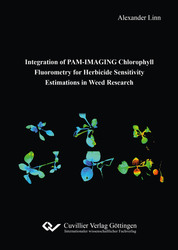| Departments | |
|---|---|
| Book Series (96) |
1377
|
| Nachhaltigkeit |
3
|
| Gesundheitswesen |
1
|
| Humanities |
2361
|
| Natural Sciences |
5403
|
| Mathematics | 229 |
| Informatics | 318 |
| Physics | 979 |
| Chemistry | 1362 |
| Geosciences | 131 |
| Human medicine | 243 |
| Stomatology | 10 |
| Veterinary medicine | 108 |
| Pharmacy | 147 |
| Biology | 835 |
| Biochemistry, molecular biology, gene technology | 121 |
| Biophysics | 25 |
| Domestic and nutritional science | 45 |
| Agricultural science | 1004 |
| Forest science | 201 |
| Horticultural science | 20 |
| Environmental research, ecology and landscape conservation | 148 |
| Engineering |
1788
|
| Common |
97
|
|
Leitlinien Unfallchirurgie
5. Auflage bestellen |
|
Advanced Search
Integration of PAM-IMAGING Chlorophyll Fluorometry for Herbicide Sensitivity Estimations in Weed Research (English shop)
Alexander Linn (Author)Preview
Table of Contents, PDF (620 KB)
Extract, PDF (680 KB)
Fast in-field herbicide resistance detection is a key requirement for future herbicide resistance management, yet secure and rapid herbicide resistance tests are still missing. Chlorophyll fluorescence and chlorophyll fluorescence ratios can be very sensitive to changes in plant health status. Recent studies have demonstrated the potential of chlorophyll fluorescence measurements to evaluate the herbicide impact on crops and weeds. The fluorescence ratio Fv/Fm quantifies the maximum quantum efficiency of photosystem II (Fv/Fm) and indicates reliably plant health status. Hitherto, research on herbicide resistance detection via the Fv/Fm value have concentrated on Alopecurus myosuroides Huds. Investigations concerning herbicide resistance detection in other important weed species, both monocotyledonous as well as dicotyledonous, have not been carried out to a large extent. This work addresses the apparent gap in knowledge by four lines of research.
| ISBN-13 (Hard Copy) | 9783736971837 |
| ISBN-13 (eBook) | 9783736961838 |
| Final Book Format | A5 |
| Language | English |
| Page Number | 66 |
| Lamination of Cover | matt |
| Edition | 1. |
| Publication Place | Göttingen |
| Place of Dissertation | Hohenheim |
| Publication Date | 2020-03-12 |
| General Categorization | Dissertation |
| Departments |
Agricultural science
Plant production Agricultural engineering |
| Keywords | Agrarwissenschaften, Herbologie, Unkrautbekämpfung, Chemischer Pflanzenschutz, Herbizid, Herbizidresistenz der Unkräuter, Unkraut, Kulturpflanze, Pflanzenstress, Pflanzenphysiologie, Chlorophyllfluoreszenz, Maximale Quantenausbeute des Photosystems II, Entscheidungsunterstützung, Photosystem II, Biologie der Unkräuter, Herbicide mode of action, Herbicide resistance detection, Precision farming, Integrated weed management, Dose-response, Herbicide resistance management, Portable PAM-imaging chlorophyll fluorometer, Classifier, Greenhouse, Field studies, Herbicide efficacy, Ackerbau, Pulse amplitude modulated chlorophyll fluorescence imaging, Ground fluorescence, Maximum fluorescence, Fluorescence ratio, Fv/Fm, ALS inhibitor, ACCase inhibitor, herbicide-resistant weed, rapid detection, laboratory study, PAM fluorimeter, discriminant analysis, plant health, weed research |








